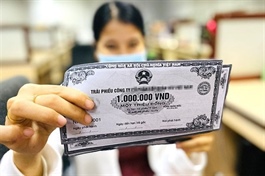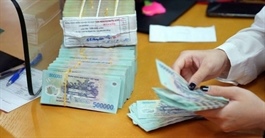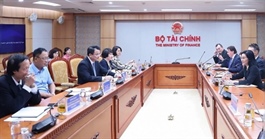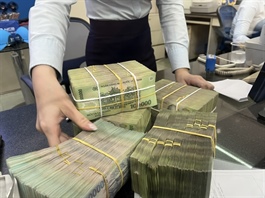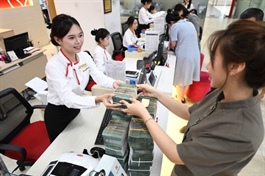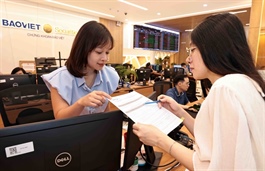USD weakness depicts foundational pressure
USD weakness depicts foundational pressure
The recent rise in the exchange rate, despite a weakening USD on global markets, appears less a market anomaly than a reflection of underlying economic pressures.
At the start of the trading session on May 14, the State Bank of Vietnam (SBV) announced the central exchange rate at 24,973 VND/USD, marking a VND585 increase since the beginning of the year and the highest level since the mechanism was introduced in early 2016.
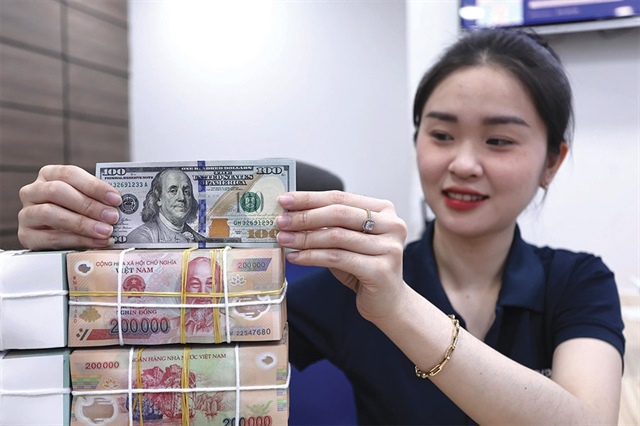
Demand for foreign currency has been fluctuating so far this year, photo Le Toan |
The USD price quoted by commercial banks hovered around VND23,731-26,123 (buy-sell), maintaining elevated levels in recent days.
According to economist Can Van Luc, although the exchange rate has risen over 2 per cent in the year-to-date, lower than earlier projections, VND is still depreciating against the USD, while other regional currencies are gaining in value.
“VND remains a weaker currency compared to regional peers. Demand for foreign currency to support import-export activities in the first four months of the year has fluctuated sharply, alongside issues of foreign currency and gold hoarding,” said Luc. “In reality, the exchange rate this year is caught in a tug-of-war with both positive and negative factors. As such, the full-year exchange rate is forecast to rise by around 3-4 per cent.”
Luc noted that in principle, a higher USD exchange rate translates into increased export revenue in VND terms, benefiting export enterprises. However, if it continues to depreciate further, it may not necessarily support exports, but instead pose the risk of imported inflation, eroding corporate profit margins.
“To hedge against exchange rate risks, businesses can choose banks with strong trade finance capabilities and utilise financial derivatives such as forward foreign exchange contracts, swaps, and other tools to scientifically plan and manage import-export operations,” he added.
On May 7, the Vietnam State Treasury (VNST) moved to purchase foreign currency amid continued upward pressure on the exchange rate, announcing plans to buy up to $150 million from commercial banks. The VNST has held eight foreign currency purchase auctions since the start of the year, with a total volume of nearly $1.5 billion.
Financial experts note that the VNST’s continued auctions of USD purchases, even while the USD remains strong, could further support upward momentum in the exchange rate.
In a report to the National Assembly last week, the SBV warned that amid a global economic environment fraught with uncertainties, the exchange rate and foreign exchange market will continue to be negatively impacted by US tariff policies, the Federal Reserve’s unpredictable monetary stance, and persistently high domestic demand for foreign currency.
“Facing these challenges, the SBV will continue to manage monetary policy in a proactive and flexible manner, in close coordination with fiscal policy, with the dual aim of stimulating economic growth while keeping inflation in check and ensuring macroeconomic stability,” said SBV Governor Nguyen Thi Hong.
In its latest monetary report, MBS analysts noted that the interbank USD/VND exchange rate has continued its upward trend, rising 2.1 per cent year-to-date to reach VND25,994 per dollar by the end of April.
According to MBS, the exchange rate increase partly stems from the SBV’s continued USD purchases, an additional $110 million from commercial banks in April, thus tightening the foreign currency supply.
“In April, interbank interest rates fell to a 13-month low, sharply reversing the interest rate differential into negative territory, which added pressure on the exchange rate. Unpredictable US tariff policy poses further challenges to Vietnam’s exports and foreign investment inflows, and could weigh on the country’s already modest foreign exchange reserves, especially after selling more than $9 billion last year,” the MBS report stated.
MBS forecasts that the exchange rate will fluctuate between 25,500 and 26,000 in 2025, amid a rebound of the greenback supported by expansionary US fiscal policy, high interest rates, and trade protectionism.
“However, positive macroeconomic fundamentals, such as a $3.79 billion trade surplus, $6.74 billion in disbursed foreign investment, and a 23.8 per cent on-year surge in international visitors, are expected to help stabilise the exchange rate in the near term,” the MBS analysts added.
|
Ngo Dang Khoa, country head of Markets and Securities Services, HSBC Vietnam The US Dollar Index (DXY) sustained a sharp downward trend throughout the month, under pressure from tariff turbulence. Despite the steep depreciation in the DXY, the USD/VND interbank exchange rate remained elevated throughout April. Several key factors help explain this development. Firstly, on April 2, US President Trump announced a tariff policy targeting trade partner countries, with Vietnam facing one of the highest rates at 46 per cent. As an open economy where trade and exports serve as key pillars of growth, the imposition of high tariffs significantly impacted Vietnam’s growth outlook and currency strength. Although the tariff plan was temporarily postponed for 90 days to allow time for negotiations, helping the USD/VND rate ease from its record high of 26,050 down to the 25,950-26,000 range by the end of April, policy uncertainty around US tariffs and broader trade directions continues to weigh heavily on market sentiment. Secondly, foreign investors maintained a net selling position on Vietnam’s stock market over the first four months of the year. Since January, net foreign outflows have reached approximately $1.4 billion, pushing the 12-month cumulative net selling total to around $3.3 billion. This persistent outflow has exerted additional pressure on the exchange rate. In contrast, persistent geopolitical tensions and volatility in global tariff policy have heightened concerns over the prospects for global trade growth and foreign investment flows into emerging markets, including Vietnam. Thirdly, trade data for the first four months showed a trade surplus of $3.79 billion, compared to a surplus of $9.06 billion during the same period last year. This marked slowdown in export growth has directly affected foreign currency inflows, adding to exchange rate pressures. Finally, the divergence in monetary policy stance between the US and Vietnam has been another contributing factor. While the Federal Open Market Committee remains in a wait-and-see mode, monitoring macroeconomic signals before making rate decisions, the State Bank of Vietnam continues to direct commercial banks to lower lending rates to support growth. As a result, the interest rate differential has remained elevated since the beginning of the year. Collectively, these factors have placed significant pressure on the exchange rate and weakened the downward momentum of the USD/VND pair, even as the greenback softened considerably on international markets. Tran Ngoc Bau, CEO, WiGroup Tariff policy remains the single most significant variable impacting the USD/VND exchange rate for the remainder of 2025. If the retaliatory tariffs imposed by the US on Vietnamese exports remain elevated at levels above 40 per cent, market sentiment is likely to remain cautious, with a continued tendency among residents and businesses to hoard USD. This behaviour stems from heightened concerns over declining export volumes and a contraction in foreign currency inflows, which together could undermine external balance and put sustained pressure on the VND. On the other hand, if ongoing trade negotiations produce meaningful progress and lead to a reduction in tariff levels to the 15-20 per cent range, this would serve as a significant catalyst for stabilising the exchange rate. Such an outcome would not only alleviate speculative pressures in the currency market but also expand the policy space for Vietnamese regulators to maintain accommodative interest rate settings in support of domestic economic growth. Currently, upward pressure on the USD/VND exchange rate is driven largely by dynamics in the onshore retail market, rather than movements within the interbank market. Consumer-level interest rates on the USD in the US are fluctuating around 7-8 per cent, compared to VND deposit rates that are averaging just 4-5 per cent. This substantial interest rate differential incentivises capital outflows and encourages the holding of USD assets, thereby intensifying domestic demand for foreign currency. While interbank interest rates between the two countries are gradually narrowing, amid expectations that the US Federal Funds Rate will average around 3.9 per cent in 2025, versus interbank VND rates of approximately 4 per cent, such convergence primarily eases pressure within the interbank system, which does not adequately reflect the broader sentiment and behavior of households and retail investors. Given Vietnam’s high trade openness and sensitivity to external shocks, the exchange rate will remain a key barometer of both systemic financial risk and macroeconomic resilience in the coming quarters. In the context of heightened uncertainty in global financial markets, Vietnamese regulators, institutional investors, and export-driven enterprises should closely track three interrelated variables, including the US Federal Reserve’s monetary policy path, the evolution of bilateral tariff negotiations, and the domestic foreign currency liquidity situation. |
- 08:00 21/05/2025







